glove box Hyundai Matrix 2007 Owner's Manual
[x] Cancel search | Manufacturer: HYUNDAI, Model Year: 2007, Model line: Matrix, Model: Hyundai Matrix 2007Pages: 490, PDF Size: 12.81 MB
Page 9 of 490
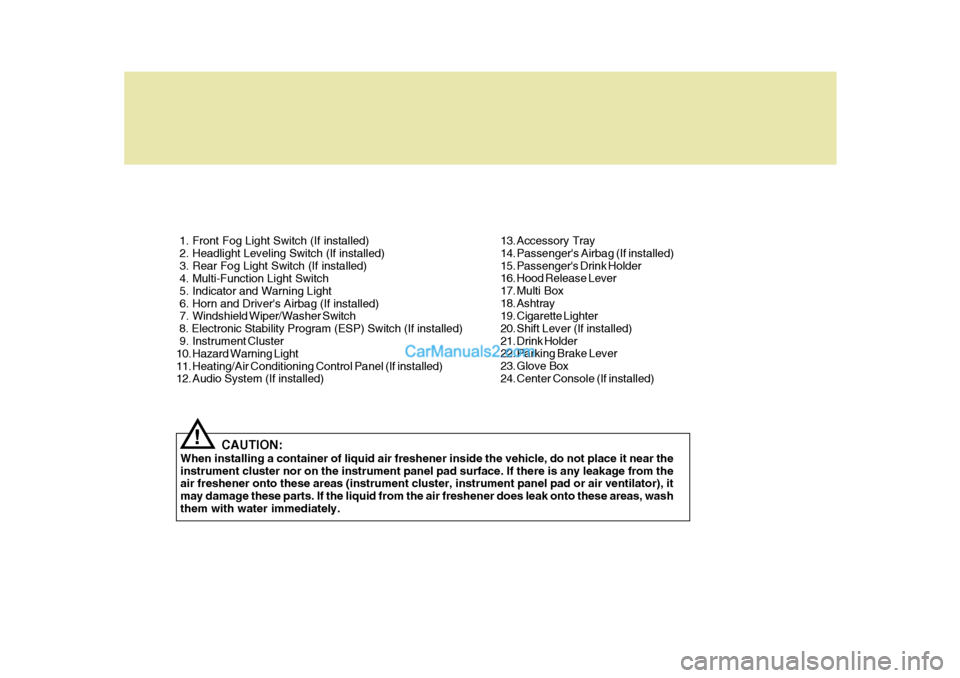
1. Front Fog Light Switch (If installed)
2. Headlight Leveling Switch (If installed)
3. Rear Fog Light Switch (If installed)
4. Multi-Function Light Switch
5. Indicator and Warning Light
6. Horn and Driver's Airbag (If installed)
7. Windshield Wiper/Washer Switch 8. Electronic Stability Program (ESP) Switch (If installed)
9. Instrument Cluster
10. Hazard Warning Light
11. Heating/Air Conditioning Control Panel (If installed)
12. Audio System (If installed)CAUTION:
When installing a container of liquid air freshener inside the vehicle, do not place it near the instrument cluster nor on the instrument panel pad surface. If there is any leakage from the air freshener onto these areas (instrument cluster, instrument panel pad or air ventilator), it may damage these parts. If the liquid from the air freshener does leak onto these areas, washthem with water immediately.
! 13. Accessory Tray
14. Passenger's Airbag (If installed)
15. Passenger's Drink Holder
16. Hood Release Lever
17. Multi Box
18. Ashtray
19. Cigarette Lighter
20. Shift Lever (If installed)
21. Drink Holder
22. Parking Brake Lever
23. Glove Box
24. Center Console (If installed)
Page 11 of 490
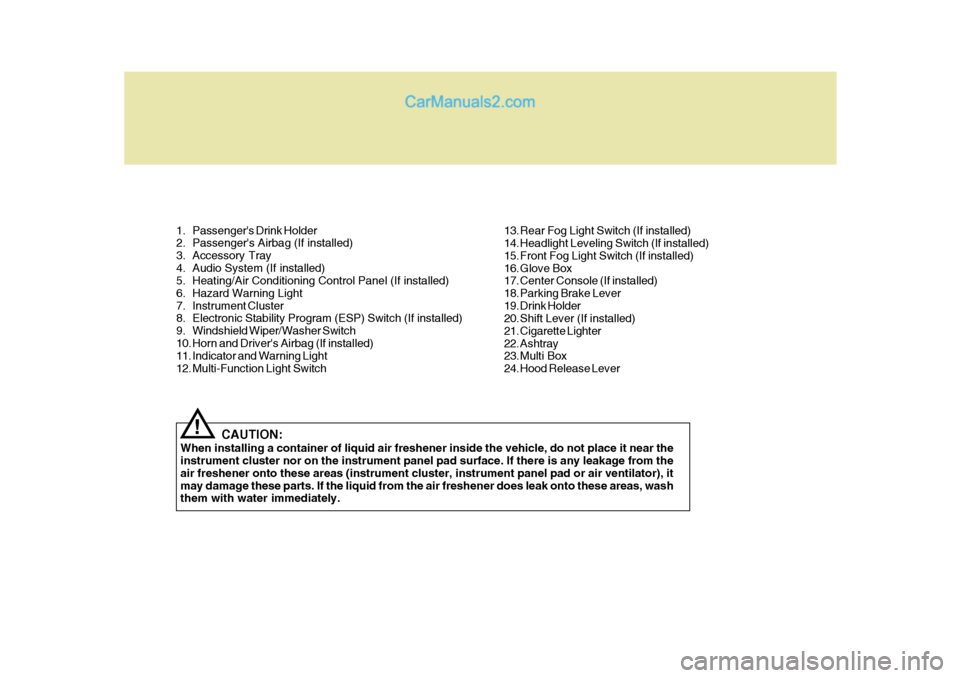
1. Passenger's Drink Holder
2. Passenger's Airbag (If installed)
3. Accessory Tray
4. Audio System (If installed)
5. Heating/Air Conditioning Control Panel (If installed)
6. Hazard Warning Light
7. Instrument Cluster
8. Electronic Stability Program (ESP) Switch (If installed)
9. Windshield Wiper/Washer Switch
10. Horn and Driver's Airbag (If installed)
11. Indicator and Warning Light
12. Multi-Function Light SwitchCAUTION:
When installing a container of liquid air freshener inside the vehicle, do not place it near the instrument cluster nor on the instrument panel pad surface. If there is any leakage from the air freshener onto these areas (instrument cluster, instrument panel pad or air ventilator), itmay damage these parts. If the liquid from the air freshener does leak onto these areas, wash them with water immediately.
! 13. Rear Fog Light Switch (If installed)
14. Headlight Leveling Switch (If installed)
15. Front Fog Light Switch (If installed)
16. Glove Box
17. Center Console (If installed)
18. Parking Brake Lever
19. Drink Holder
20. Shift Lever (If installed)
21. Cigarette Lighter
22. Ashtray
23. Multi Box
24. Hood Release Lever
Page 49 of 490
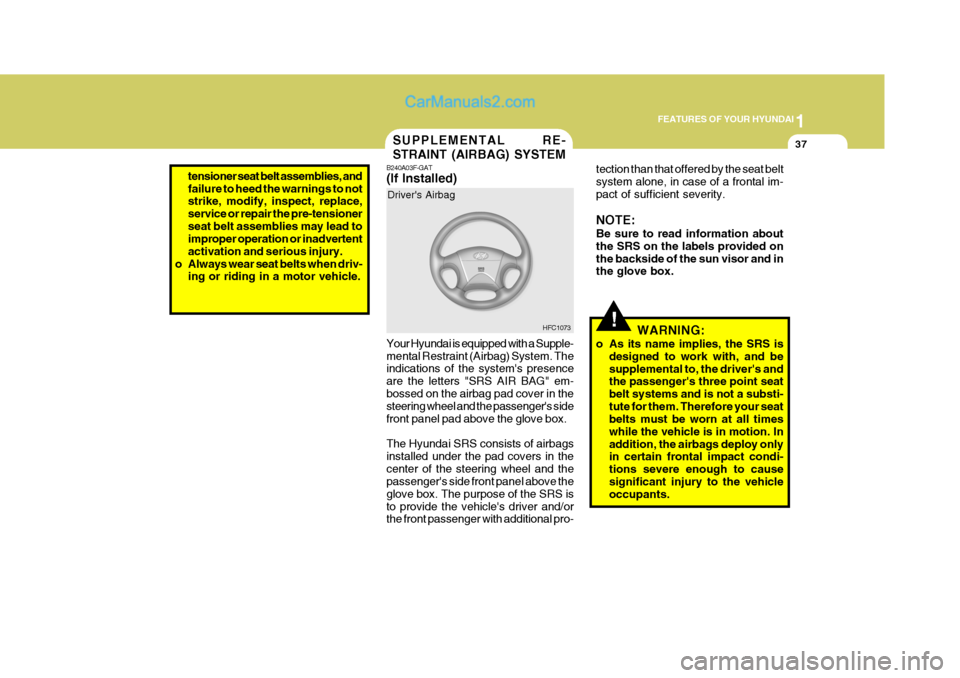
1
FEATURES OF YOUR HYUNDAI
37
tensioner seat belt assemblies, and failure to heed the warnings to not strike, modify, inspect, replace, service or repair the pre-tensionerseat belt assemblies may lead to improper operation or inadvertent activation and serious injury.
o Always wear seat belts when driv- ing or riding in a motor vehicle. B240A03F-GAT (If Installed) Your Hyundai is equipped with a Supple- mental Restraint (Airbag) System. The indications of the system's presence are the letters "SRS AIR BAG" em-bossed on the airbag pad cover in the steering wheel and the passenger's side front panel pad above the glove box. The Hyundai SRS consists of airbags installed under the pad covers in thecenter of the steering wheel and the passenger's side front panel above the glove box. The purpose of the SRS isto provide the vehicle's driver and/or the front passenger with additional pro-HFC1073
Driver's Airbag
SUPPLEMENTAL RE- STRAINT (AIRBAG) SYSTEM
!
tection than that offered by the seat belt system alone, in case of a frontal im-pact of sufficient severity. NOTE: Be sure to read information about the SRS on the labels provided onthe backside of the sun visor and in the glove box.
WARNING:
o As its name implies, the SRS is designed to work with, and be supplemental to, the driver's and the passenger's three point seat belt systems and is not a substi-tute for them. Therefore your seat belts must be worn at all times while the vehicle is in motion. Inaddition, the airbags deploy only in certain frontal impact condi- tions severe enough to causesignificant injury to the vehicle occupants.
Page 50 of 490
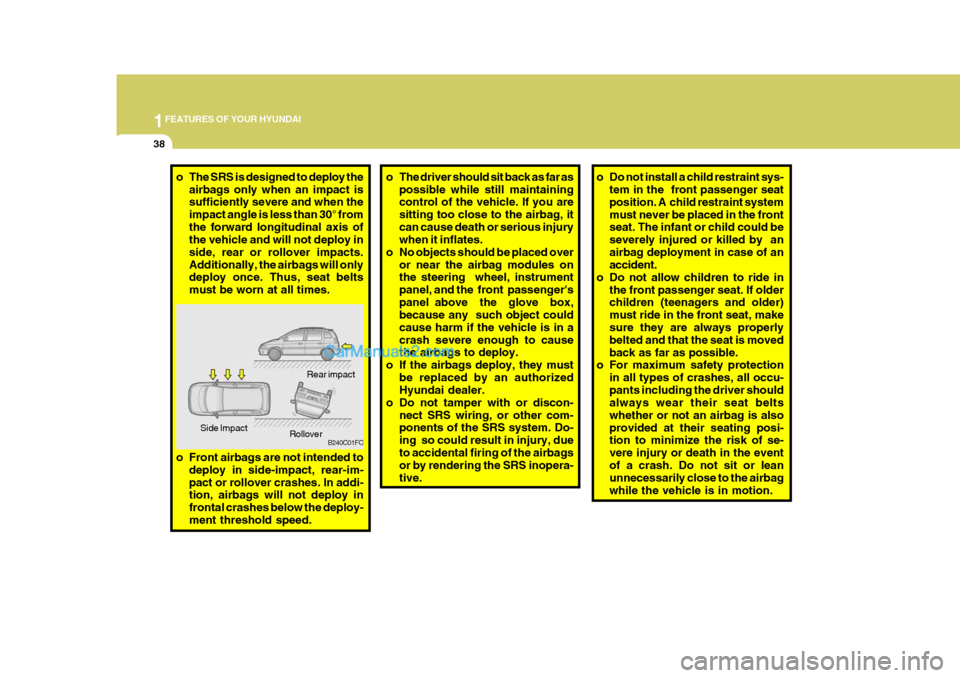
1FEATURES OF YOUR HYUNDAI
38
o Front airbags are not intended to
deploy in side-impact, rear-im- pact or rollover crashes. In addi- tion, airbags will not deploy in frontal crashes below the deploy-ment threshold speed.
o Do not install a child restraint sys-tem in the front passenger seat position. A child restraint systemmust never be placed in the front seat. The infant or child could be severely injured or killed by anairbag deployment in case of an accident.
o Do not allow children to ride in
the front passenger seat. If olderchildren (teenagers and older) must ride in the front seat, makesure they are always properly belted and that the seat is moved back as far as possible.
o For maximum safety protection
in all types of crashes, all occu-pants including the driver should always wear their seat belts whether or not an airbag is alsoprovided at their seating posi- tion to minimize the risk of se- vere injury or death in the eventof a crash. Do not sit or lean unnecessarily close to the airbag while the vehicle is in motion.o The driver should sit back as far as
possible while still maintaining control of the vehicle. If you are sitting too close to the airbag, itcan cause death or serious injury when it inflates.
o No objects should be placed over or near the airbag modules onthe steering wheel, instrument panel, and the front passenger'spanel above the glove box, because any such object could cause harm if the vehicle is in acrash severe enough to cause the airbags to deploy.
o If the airbags deploy, they must be replaced by an authorizedHyundai dealer.
o Do not tamper with or discon- nect SRS wiring, or other com-ponents of the SRS system. Do- ing so could result in injury, dueto accidental firing of the airbags or by rendering the SRS inopera- tive.
o The SRS is designed to deploy the
airbags only when an impact is sufficiently severe and when the impact angle is less than 30° fromthe forward longitudinal axis of the vehicle and will not deploy in side, rear or rollover impacts.Additionally, the airbags will only deploy once. Thus, seat belts must be worn at all times.
B240C01FC
Rear impact
Side Impact Rollover
Page 51 of 490
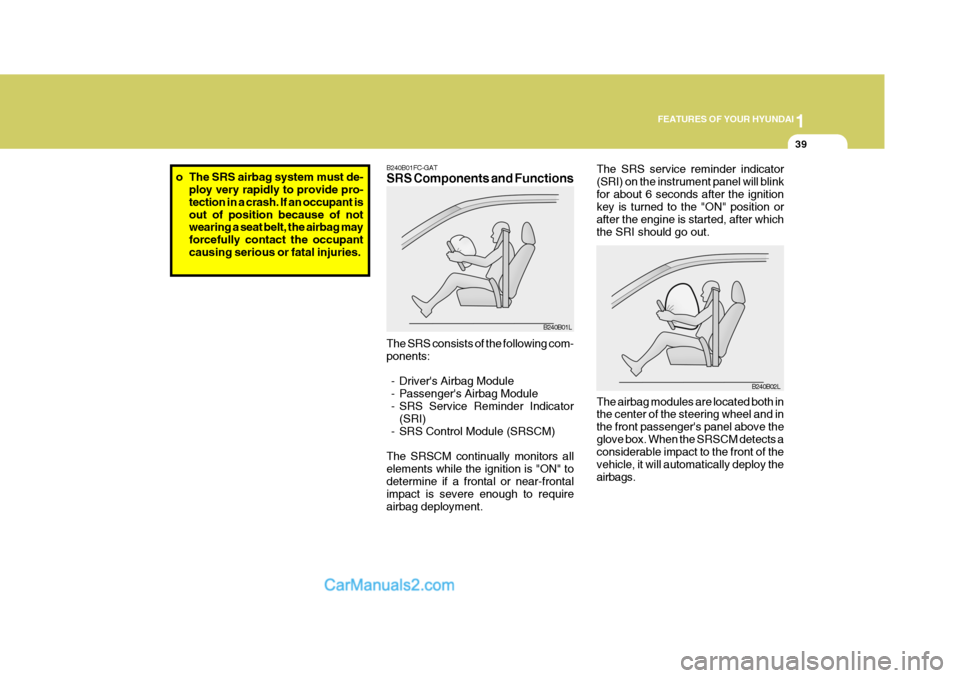
1
FEATURES OF YOUR HYUNDAI
39
o The SRS airbag system must de-
ploy very rapidly to provide pro- tection in a crash. If an occupant isout of position because of not wearing a seat belt, the airbag may forcefully contact the occupantcausing serious or fatal injuries. B240B01FC-GAT SRS Components and Functions
B240B01L
The SRS consists of the following com- ponents:
- Driver's Airbag Module
- Passenger's Airbag Module
- SRS Service Reminder Indicator (SRI)
- SRS Control Module (SRSCM)
The SRSCM continually monitors all elements while the ignition is "ON" to determine if a frontal or near-frontal impact is severe enough to requireairbag deployment. B240B02L
The airbag modules are located both in the center of the steering wheel and in the front passenger's panel above theglove box. When the SRSCM detects a considerable impact to the front of the vehicle, it will automatically deploy theairbags.
The SRS service reminder indicator(SRI) on the instrument panel will blinkfor about 6 seconds after the ignition key is turned to the "ON" position or after the engine is started, after whichthe SRI should go out.
Page 52 of 490
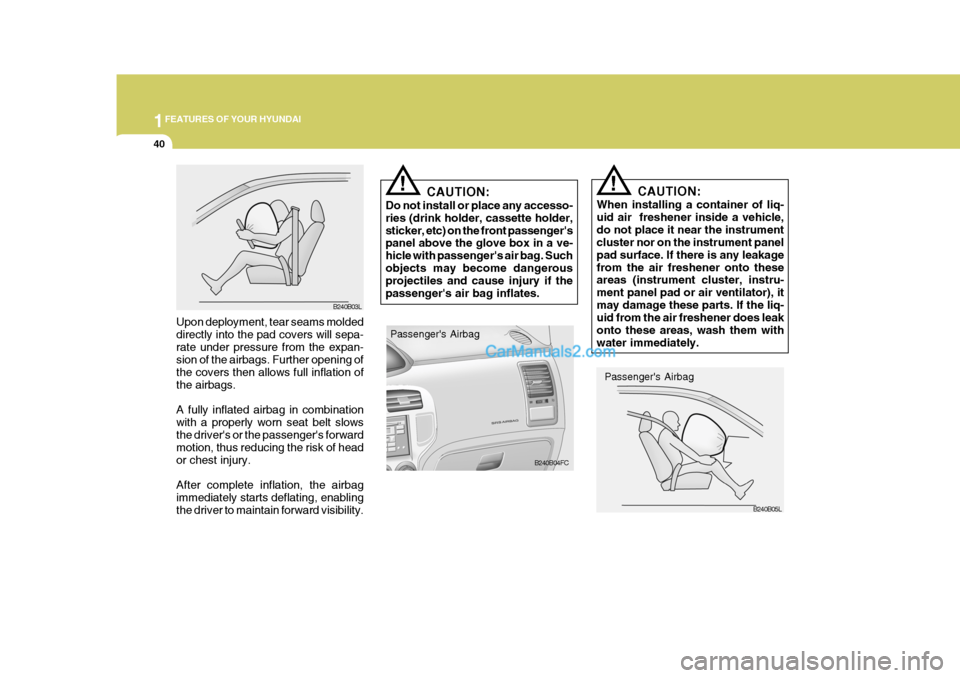
1FEATURES OF YOUR HYUNDAI
40
CAUTION:
When installing a container of liq- uid air freshener inside a vehicle,do not place it near the instrument cluster nor on the instrument panel pad surface. If there is any leakagefrom the air freshener onto these areas (instrument cluster, instru- ment panel pad or air ventilator), itmay damage these parts. If the liq- uid from the air freshener does leak onto these areas, wash them withwater immediately.!
CAUTION:
Do not install or place any accesso- ries (drink holder, cassette holder,sticker, etc) on the front passenger's panel above the glove box in a ve- hicle with passenger's air bag. Suchobjects may become dangerous projectiles and cause injury if the passenger's air bag inflates.!
Passenger's AirbagB240B05L
B240B03L
Upon deployment, tear seams molded directly into the pad covers will sepa-rate under pressure from the expan- sion of the airbags. Further opening of the covers then allows full inflation ofthe airbags. A fully inflated airbag in combination with a properly worn seat belt slows the driver's or the passenger's forward motion, thus reducing the risk of heador chest injury. After complete inflation, the airbag immediately starts deflating, enabling the driver to maintain forward visibility. Passenger's Airbag
B240B04FC
Page 55 of 490
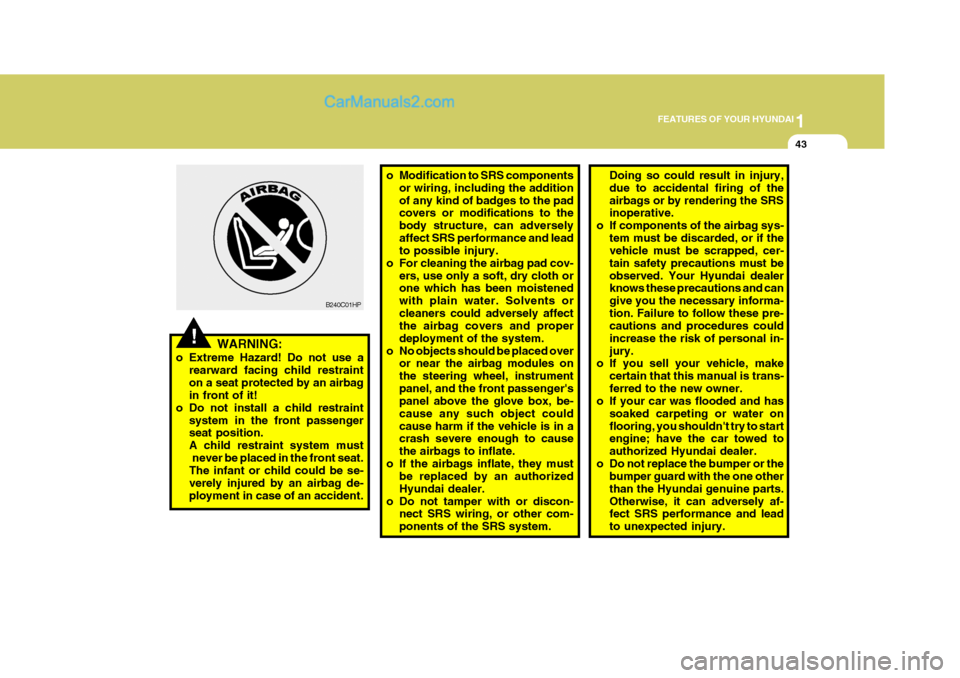
1
FEATURES OF YOUR HYUNDAI
43
B240C01HP
!
o Modification to SRS components
or wiring, including the addition of any kind of badges to the pad covers or modifications to the body structure, can adverselyaffect SRS performance and lead to possible injury.
o For cleaning the airbag pad cov- ers, use only a soft, dry cloth orone which has been moistened with plain water. Solvents orcleaners could adversely affect the airbag covers and proper deployment of the system.
o No objects should be placed over or near the airbag modules onthe steering wheel, instrumentpanel, and the front passenger's panel above the glove box, be- cause any such object couldcause harm if the vehicle is in a crash severe enough to cause the airbags to inflate.
o If the airbags inflate, they must be replaced by an authorizedHyundai dealer.
o Do not tamper with or discon- nect SRS wiring, or other com-ponents of the SRS system.
WARNING:
o Extreme Hazard! Do not use a rearward facing child restrainton a seat protected by an airbag in front of it!
o Do not install a child restraint system in the front passengerseat position. A child restraint system must
never be placed in the front seat. The infant or child could be se- verely injured by an airbag de-ployment in case of an accident. Doing so could result in injury,due to accidental firing of theairbags or by rendering the SRS inoperative.
o If components of the airbag sys-
tem must be discarded, or if thevehicle must be scrapped, cer- tain safety precautions must beobserved. Your Hyundai dealer knows these precautions and can give you the necessary informa-tion. Failure to follow these pre- cautions and procedures could increase the risk of personal in-jury.
o If you sell your vehicle, make
certain that this manual is trans-ferred to the new owner.
o If your car was flooded and has
soaked carpeting or water onflooring, you shouldn't try to start engine; have the car towed to authorized Hyundai dealer.
o Do not replace the bumper or the bumper guard with the one otherthan the Hyundai genuine parts.Otherwise, it can adversely af- fect SRS performance and lead to unexpected injury.
Page 82 of 490

1FEATURES OF YOUR HYUNDAI
70
HFC1038
HFC1037
B460D01FC-GAT Manual Operation of Sunroof If the sunroof does not operate electri- cally:
1. Remove the rectangular plastic inte- rior light lens in the front overhead console.
2. Turn the hexagonal bolts with a
socketwrench counterclockwise toremove the front overhead console. HFC1036
3. Insert the hexagonal head wrench
provided with the vehicle into thesocket. This wrench can be found in the vehicle's luggage room or glovebox.
4. Turn the wrench clockwise to open or counterclockwise to close.B460C02S-AAT Tilting the Sunroof The sunroof can be tilted by pushing the "UP" button with the sunroof closed. Release the button when the sunroof reaches the desired position. To closethe sunroof, press the "DOWN" but- ton. HFC2022
NOTE: After washing the car or after there is rain, be sure to wipe off any water that is on the sunroof before operat-ing it.
Page 85 of 490

1
FEATURES OF YOUR HYUNDAI
73
To adjust the position of either mirror:
1. Move the selecting switch to the
right or left to activate the adjustable mechanism for the correspondingdoor mirror.
2. Adjust mirror angle by depressing
the appropriate directional switchas illustrated.
B510D01EB510B01FC-GAT OUTSIDE REARVIEW MIRROR Electric Type The outside rearview mirrors can be adjusted to your preferred rear vision, both directly behind the vehicle, and to the rear of the left and right sides.The remote control outside rearview mirror switch controls the adjustments for both right and left outside mirrors. HFC2011
MIRROR
!
GLOVE BOX
B500A01A-AAT
WARNING:
To avoid the possibility of injury in case of an accident or a sudden stop, the glove box door should bekept closed when the car is in mo- tion.
o To open the glove box, pull on the glove box release lever. HFC2095
Page 111 of 490

1
FEATURES OF YOUR HYUNDAI
99
1
FEATURES OF YOUR HYUNDAI
99CLIMATE CONTROL AIR FILTER (IN FRONT OF BLOWER UNIT)
B760A05FC-AAT The climate control air filter is located in front of the blower unit behind the glove box. It operates to decrease pollutantsfrom entering the car. To replace the climate control air filter, refer to page 6-25. CAUTION:
o Replace the filter every 15,000 km (10,000 miles) or once a year. If thecar is being driven in severe con-ditions such as dusty, rough roads, more frequent climate con- trol air filter inspections andchanges are required.
o When the air flow rate is suddenly
decreased, the system should bechecked at an authorized dealer.
!
B760A01E
Evaporator core Filter
Heater core
Outside air
Inside air Inside air
Blower fan
STEREO SOUND SYSTEM
Ionosphere
FM reception
B750A01L
B750A02A-AAT How Car Audio Works
AM and FM radio signals are broadcast from transmitter towers located aroundyour city. They are intercepted by the radio antenna on your car. This signal is then received by the radio and sent toyour car speakers. When a strong radio signal has reached your vehicle, the precise engineering ofyour audio system ensures high quality reproduction. However, in some cases the signal coming to your vehicle maynot be strong and clear. This can be due to factors such as the distance from the radio station, closeness of other strongradio stations or the presence of build- ings, bridges and other large obstruc- tions in the area.